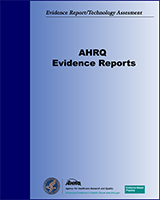NCBI Bookshelf. A service of the National Library of Medicine, National Institutes of Health.
McCrory DC, Brown C, Gray RN, et al. Management of Acute Exacerbations of Chronic Obstructive Pulmonary Disease. Rockville (MD): Agency for Healthcare Research and Quality (US); 2001 Mar. (Evidence Reports/Technology Assessments, No. 19.)
This publication is provided for historical reference only and the information may be out of date.
The most significant problem in the literature is the lack of a system for describing the severity of acute exacerbation of COPD. A system is important for improving the quality and applicability of clinical research on acute exacerbation of COPD.
Acute exacerbation of COPD is studied less often than one might expect, considering its prevalence and high cost. More studies that directly inform the management of patients presenting with acute exacerbation of COPD are needed that would cover issues such as triage to hospital or outpatient care, use of aggressive bronchodilator treatment, and the effectiveness of combined interventions. Multisite studies like the Veterans Affairs' SCCOPE trial have been successful at recruiting the number of patients needed for the statistical power necessary to answer clinical questions.
A classification of patients has been proposed (which is based primarily on association with microbial pathogens) as a means of guiding antimicrobial treatment (Grossman, 1997). This approach to selection of antibiotics should be validated in a prospective trial to test its effectiveness in clinical practice. Because of the array of different therapies that are aimed at different physiological derangements in acute exacerbation of COPD, it is likely that other systems may be necessary to guide decisions about other treatments for these exacerbations. For example, it may be necessary to have one scale related to likely microbial pathogens to guide antibiotic treatment, another to assess airway reactivity and likely response to different bronchodilator treatments, and another to assess ventilatory function and the need for ventilatory assistance.
Most published studies in acute exacerbation of COPD are conducted in patients who require hospitalization. However, most of the burden of this disease occurs in the outpatient setting. More studies are needed that are relevant to outpatient management decisions and that focus on patients who present in office-based practices or by telephone.
More information also is needed on the effects of the newer anticholinergic, tiotropium bromide, with and without beta2-agonists. Salmeterol, a long-acting beta2-agonist, is being used with increasing frequency in the COPD population. Studies to determine if this drug has an effect on the frequency, severity, or treatment of acute exacerbation of COPD are warranted. Additional research should be conducted to find the optimal bronchodilator dose and the best delivery method in exacerbation. Lloberes, Ramis, Montserrat, et al. (1988) showed a lack of benefit from adding bronchodilators after a first one had been used to achieve a maximal effect. This study needs to be validated by future studies. Such studies also would help to determine the best dosing regimen for patients with exacerbations.
Although current research has adequately demonstrated that NPPV can reduce the need for invasive ventilation, additional research efforts are needed to improve the tolerability of this therapy. Experimentation with ventilator modes and newer mask interfaces for administering NPPV are likely directions. Further study of the appropriate selection of patients in whom to try NPPV and of the timing of the intervention may help to define the best method for incorporating this treatment modality into the care of patients with acute exacerbation of COPD in the ED or outpatient setting, as well as after hospital admission
- Future Research - Management of Acute Exacerbations of Chronic Obstructive Pulmo...Future Research - Management of Acute Exacerbations of Chronic Obstructive Pulmonary Disease
Your browsing activity is empty.
Activity recording is turned off.
See more...
